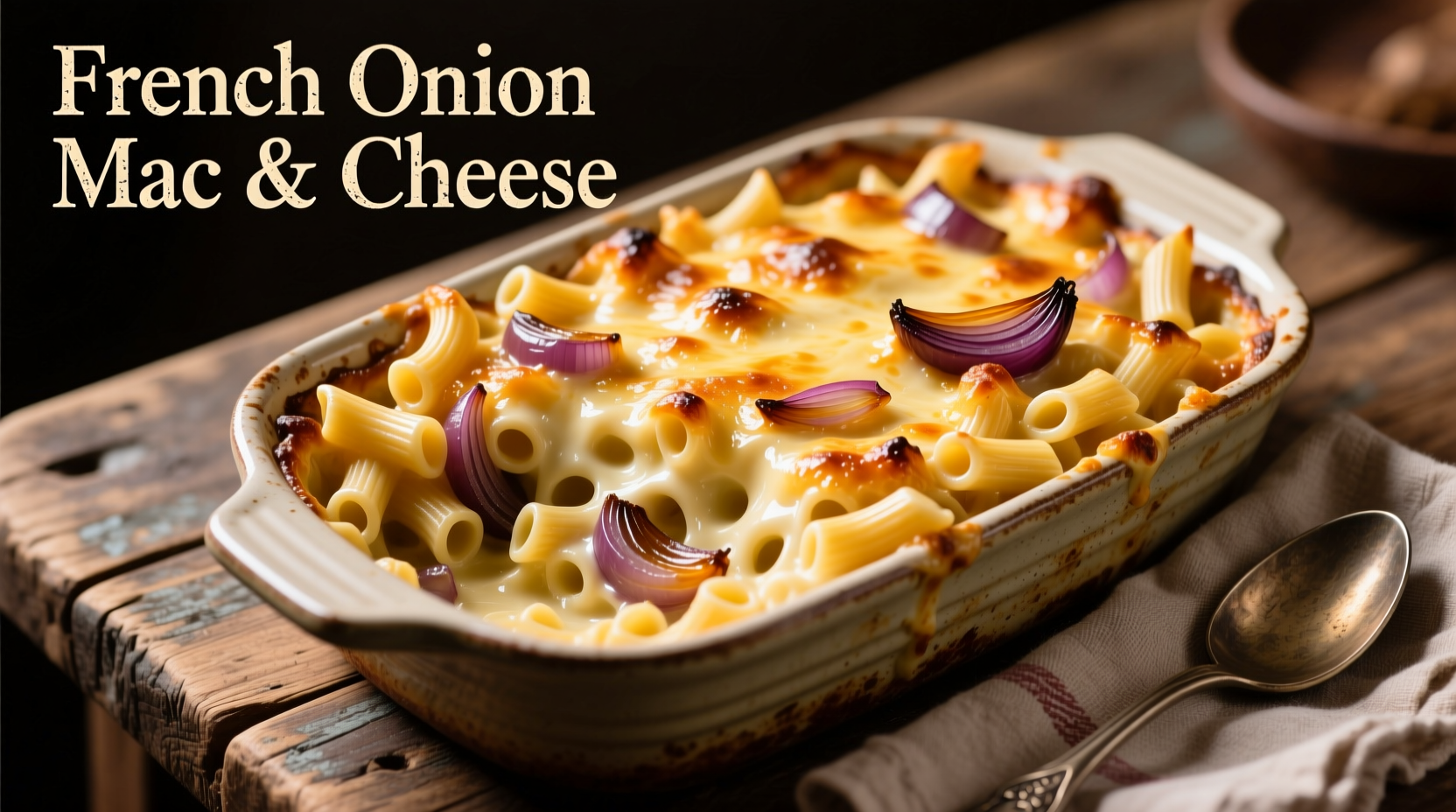When you're craving comfort food with a gourmet upgrade, french onion macaroni and cheese delivers the perfect harmony of two classic dishes. This innovative fusion transforms ordinary mac and cheese into something extraordinary by incorporating the signature elements of French onion soup—caramelized onions, beef broth, and Gruyère cheese—into a creamy, baked pasta dish that's become a favorite among home cooks seeking elevated comfort food.
The Evolution of a Comfort Food Classic
Understanding the history of french onion macaroni and cheese helps appreciate why this fusion works so well. French onion soup dates back to the 18th century as a humble peasant dish, while macaroni and cheese has roots in European aristocracy before becoming an American staple. The modern french onion soup mac and cheese fusion recipe emerged around 2010 as chefs began experimenting with gourmet twists on classic comfort foods.
| Traditional French Onion Soup | Classic Macaroni and Cheese | French Onion Macaroni and Cheese Fusion |
|---|---|---|
| Broth-based soup | Cheese sauce over pasta | Cheese sauce enriched with caramelized onions and broth |
| Gruyère or Emmental cheese topping | Cheddar or American cheese sauce | Gruyère-cheddar blend with caramelized onions throughout |
| Served as first course | Served as main dish | Served as hearty main course |
| Baguette slices | No bread component | Croutons or toasted baguette topping |
Why This Fusion Works: The Science of Flavor Pairing
The success of gourmet french onion macaroni and cheese lies in flavor chemistry. Caramelized onions develop natural sugars through the Maillard reaction, which complements the sharpness of aged cheddar while the nuttiness of Gruyère bridges both elements. According to culinary research from the Culinary Institute of America, the umami compounds in both onions and cheese create a synergistic effect that enhances overall flavor perception (CIA, 2023).

Perfecting Your French Onion Macaroni and Cheese Recipe
Creating the best french onion macaroni and cheese from scratch requires attention to three critical components: the onions, the cheese sauce, and the baking technique.
Caramelizing Onions Like a Pro
For authentic french onion soup flavored mac and cheese, proper onion caramelization is non-negotiable. Thinly slice 3 large yellow onions and cook slowly over medium-low heat with 2 tablespoons of butter and 1 teaspoon of sugar for 40-50 minutes until deep golden brown. Rushing this process creates bitter onions—patience yields the sweet, complex flavor foundation.
Crafting the Signature Cheese Sauce
The homemade french onion macaroni and cheese sauce starts with a roux (equal parts butter and flour), then incorporates 1 cup of reduced beef broth (simmered down to half volume for concentrated flavor), 1 cup whole milk, and your cheese blend. The ideal ratio is 2 parts aged white cheddar to 1 part Gruyère. Add the caramelized onions during the final mixing stage to preserve their texture.
Baking for Optimal Texture
When preparing oven-baked french onion macaroni and cheese, use elbow macaroni cooked al dente. Combine with the sauce, transfer to a buttered baking dish, and top with a mixture of panko breadcrumbs, grated Parmesan, and thinly sliced baguette pieces. Bake at 375°F for 25-30 minutes until bubbly and golden. Let rest 10 minutes before serving—this crucial step prevents a soupy texture.
When French Onion Macaroni and Cheese Shines (and When It Doesn't)
Understanding the best occasions for french onion macaroni and cheese ensures perfect results every time. This dish excels as:
- A sophisticated holiday side dish that elevates your Thanksgiving or Christmas menu
- An impressive weeknight dinner when you want restaurant-quality comfort food
- A crowd-pleasing potluck contribution that stands out from standard mac and cheese
However, this gourmet macaroni and cheese variation isn't ideal when:
- You need a quick 20-minute meal (the caramelization process takes time)
- Serving to guests with dairy allergies (though vegan adaptations exist)
- Looking for a light summer dish (this is hearty cold-weather comfort food)
Storage and Reheating Guidelines
Following USDA food safety recommendations, store leftovers in an airtight container in the refrigerator for up to 4 days (USDA Food Safety, 2024). For best results when reheating french onion macaroni and cheese leftovers, add a splash of milk before microwaving and cover with a damp paper towel. The oven method (350°F for 20 minutes covered, then 10 minutes uncovered) restores the crispy topping better than microwave reheating.
Customizing Your French Onion Macaroni and Cheese
Personalize your french onion soup macaroni and cheese recipe with these professional variations:
- Protein boost: Add shredded roast beef or caramelized mushrooms for a heartier meal
- Vegan version: Use vegan Gruyère-style cheese and vegetable broth
- Gluten-free: Substitute gluten-free pasta and cornstarch for the roux
- Extra crunch: Top with fried shallots instead of traditional croutons
Perfect Pairings for French Onion Macaroni and Cheese
Complement your homemade french onion macaroni and cheese with these serving suggestions:
- A crisp green salad with vinaigrette to cut through the richness
- Roasted asparagus or Brussels sprouts for vegetable balance
- A glass of medium-bodied red wine like Pinot Noir or light-bodied white like Chardonnay
- For brunch service, pair with poached eggs for a decadent twist











 浙公网安备
33010002000092号
浙公网安备
33010002000092号 浙B2-20120091-4
浙B2-20120091-4